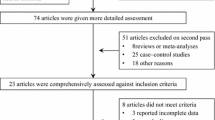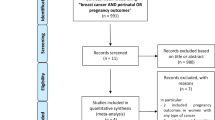Abstract
Objective
To evaluate the association between induced abortion (IA) and breast cancer risk among Chinese females.
Methods
We searched three English databases (PubMed, ScienceDirect, and Wiley) and three Chinese databases (CNKI, WanFang, and VIP) for studies up to December 2012, supplemented by manual searches. Two reviewers independently conducted the literature searching, study selection, and data extraction and quality assessment of included studies. Random effects models were used to estimate the summary odds ratios (ORs) and the 95 % confidence intervals (CIs).
Results
A total of 36 articles (two cohort studies and 34 case–control studies) covering 14 provinces in China were included in this review. Compared to people without any history of IA, an increased risk of breast cancer was observed among females who had at least one IA (OR = 1.44, 95 % CI 1.29–1.59, I 2 = 82.6 %, p < 0.001, n = 34). No significant publication bias was found among the included studies (Egger test, p = 0.176). The risk increased to 1.76 (95 % CI 1.39–2.22) and 1.89 (95 % CI 1.40–2.55) for people who had at least two IAs and at least three IAs, respectively. Subgroup analyses showed similar results to the primary results. Meta-regression analysis of the included studies found that the association between IA and breast cancer risk attenuated with increasing percent of IA in the control group (β = −0.022, p < 0.001).
Conclusion
IA is significantly associated with an increased risk of breast cancer among Chinese females, and the risk of breast cancer increases as the number of IA increases. If IA were to be confirmed as a risk factor for breast cancer, high rates of IA in China may contribute to increasing breast cancer rates.






Similar content being viewed by others
References
Li N, Zheng RS, Zhang SW et al (2012) Analysis and prediction of breast cancer incidence trend in China. Chin J Prev Medicine 46:703–707
Qiao XC (2002) Analysis of induced abortion of Chinese women. Popul Res 26:16–25
Chinese Ministry of Health (2012) China Health Statistics Yearbook of 2011. Peking Union Medical College Press, Beijing, China
Russo J, Russo IH (1987) Biological and molecular bases of mammary carcinogenesis. Lab Invest 57:112–137
Kelsey JL (1979) A review of the epidemiology of human breast cancer. Epidemiol Rev 1:74–109
Kelsey JL, Fischer DB, Holford TR et al (1981) Exogenous estrogens and other factors in the epidemiology of breast cancer. J Natl Cancer Inst 67:327–333
Brind J, Chinchilli VM, Severs WB, Summy-Long J (1996) Induced abortion as an independent risk factor for breast cancer: a comprehensive review and meta-analysis. J Epidemiol Community Health 50:481–496
Beral V, Bull D, Doll R et al (2004) Breast cancer and abortion: collaborative reanalysis of data from 53 epidemiological studies, including 83000 women with breast cancer from 16 countries. Lancet 363:1007–1016
Ye Z, Gao DL, Qin Q et al (2002) Breast cancer in relation to induced abortions in a cohort of Chinese women. Br J Cancer 87:977–981
Sanderson M, Shu XO, Jin F et al (2001) Abortion history and breast cancer risk: results from the Shanghai breast cancer study. Int J Cancer 92:899–905
Jiang A, Gao C, Ding J et al (2012) Abortions and breast cancer risk in premenopausal and postmenopausal women in Jiangsu Province of China. Asian Pac J Cancer Prev 13:33–35
Davidson T (2001) Abortion and breast cancer: a hard decision made harder. Lancet Oncol 2:756–758
Wingo PA, Newsome K, Marks JS et al (1997) The risk of breast cancer following spontaneous or induced abortion. Cancer Causes Control 8:93–108
Brind J, Chinchilli VM (2004) Breast cancer and induced abortions in China. Br J Cancer 90(2244–2245):2245–2246
Stroup DF, Berlin JA, Morton SC et al (2000) Meta-analysis of observational studies in epidemiology: a proposal for reporting. Meta-analysis of observational studies in epidemiology (MOOSE) group. JAMA 283:2008–2012
Wells G, Shea B, O’Connell D et al (2012) The Newcastle–Ottawa Scale (NOS) for assessing the quality of nonrandomised studies in meta-analyses. http://www.ohri.ca/programs/clinical_epidemiology/oxford.asp. Accessed 10 May 2013
Higgins JP, Thompson SG, Deeks JJ, Altman DG (2003) Measuring inconsistency in meta-analyses. BMJ 327:557–560
Begg CB, Mazumdar M (1994) Operating characteristics of a rank correlation test for publication bias. Biometrics 50:1088–1101
Egger M, Davey SG, Schneider M, Minder C (1997) Bias in meta-analysis detected by a simple, graphical test. BMJ 315:629–634
Higgins JP, Thompson SG (2004) Controlling the risk of spurious findings from meta-regression. Stat Med 23:1663–1682
Liu B, Gao ES (2002) Risk factors for spontaneous abortion of Chinese married women at reproductive age. China Public Health 18:890–892
Jiang HY, Hou Q (2008) Survey on spontaneous abortion among reproductive women in Nanchang city. China J Public Health 24:149–151
Jiang AR, Gao CM, Ding JH et al (2012) A case control study of the relationship between abortion and risk of breast cancer. China Cancer 21:264–267
Zhang X, Wang XT, Gou CZ et al (1998) A case-control study fertility risk factors of female breast cancer in Lanzhou. J PLA Jr Coll Med 26:28–30
Zhang ZB (2003) Case-control study on the association between induced abortion and breast cancer. Dissertation, Fudan University
Cao ML (2008) The association between the circadian gene PER3 polymorphism and the susceptibility of breast cancer. Dissertation, Tianjin Medical University
Wang YQ (2006) Case-control study on the risk factors of breast cancer based on a cohort population in Jiashan Country. Dissertation, Zhejiang University, Zhejiang
Ren XN (2008) A 1:1 case-control study on risk factors of breast cancer. Dissertation, Dalian Medical University, Liaoning, China
Ji YL (2007) Case-control study on the associations of genetic polymorphisms of ER and PR with the risk of breast cancer. Dissertation, Suzhou University, Jiangsu
Xing P, Li J, Jin F (2010) A case-control study of reproductive factors associated with subtypes of breast cancer in Northeast China. Med Oncol 27:926–931
Qiu J, Yang R, Rao Y et al (2012) Risk factors for breast cancer and expression of insulin-like growth factor-2 (IGF-2) in women with breast cancer in Wuhan City, China. PLoS One 7:e36497
Wang Q, Li H, Tao P et al (2011) Soy isoflavones, CYP1A1, CYP1B1, and COMT polymorphisms, and breast cancer: a case-control study in southwestern China. DNA Cell Biol 30:585–595
Li JY, Sheng W, Yang F et al (2006) Study on serum organochlorines pesticides (DDTs) level, CYP1A1 genetic polymorphism and risk of breast cancer: a case control study. Chin J Epidemiol 27:217–222
Zhu XL, Dai HJ, Cao ML et al (2011) Genetic polymorphisms in CLOCK and increased risk of breast cancer: a case control study. Chin J Clin Oncol 38:121–125
Rong SY, Wang Q, Li J et al (2010) Relationship between organochlorine pesticides exposure after Tangshan earthquake and breast cancer: a case-control study. J Environ Health 27:131–134
Li XD, Rao KQ, Li Z (2009) Relationship between reproductive factors and breast cancer for women in six cities of China: a case-control study. Chin J Health Educ 25(431–433):449
Jian J, Li Y, Zhang HW, Bu LM (2000) Breast cancer and induced abortion in a low-risk population. J Prev Med Inf 16:16–19
Wang XT, Zhang X, Li HB et al (1997) A case-control study on life events of female breast cancer in Lanzhou city. Gansu Med J 16:241–243
Yu ZG, Jia CX, Geng CZ et al (2012) Risk factors related to female breast cancer in regions of Northeast China: a 1:3 matched case-control population-based study. Chin Med J (Engl) 125:733–740
Pang Y, Li H, Lei FM et al (2009) A case control study on association between reproductive factors and risk of breast cancer. Chin J Public Health 25:1172–1174
Huang XM, Wang CX, Zhou YS, Zeng Y (2006) A elementary study on risk factors of breast cancer of women in Shenzhen Baoan area. Central Plains Med J 33:37–39
Shi XS, Wu B, Hu ZJ et al (2000) A case-control study on risk factors of breast cancer for women in Fuzhou. Strait J Prev Med 6:12–14
Shi P, Xu M, Qian Y, Wu LL (2010) Matched case–control study for detecting risk factors of breast cancer in women living in Wuxi. Mod Prev Med 37:2428–2431
Zeng Y, Xu MS, Tan SQ, Yin L (2010) Analysis of the risk factors of breast cancer. J South Med Univ 30:622–623
Lin J, Yu JF (2008) A case-control study on risk factors of breast cancer among women in Cixi. Zhejiang J Prev Med 20:3–5
Li XL, He M, Xu ZY et al (2006) A case-control study on risk factors of female breast cancer. Chin J Dis Control Prev 10:8–11
Zhai XJ (2006) Molecular epidemiology study of risk factors and genetic susceptibility of breast cancer in Chinese population. Dissertation, Nanjing Medical University, Jiangsu
Li YY (2011) The report of breast disease screening in Shandong Province and breast cancer risk factors analysis. Dissertation, Shandong University, Shandong
Li HL, Gao LF, Yang G et al (2000) Reproductive factors and breast cancer in a population-based case-control study. Tumor 20:88–92
Zhang XJ, Wang XM, Dai HM (2001) Investigation the relationship between breast cancer and induced abortion. Chin Prim Health Care 15:61
Li M, Wang L (2010) Case-control study on the risk factors of breast cancer. Occup Health 26:2651–2653
Liu JY, Shen HB, Jin GF et al (2008) The risk factors of breast cancer in Chinese women: a case-control analysis. Acta Univ Med Nanjing (Nat Sci) 28:689–692
Li N, He M, Zhang X et al (2006) Breast cancer genetic epidemiology study and conditional logistic regression analysis of relative risk factors of female in hospital in liaoning province. Chin J Cancer Prev Treat 13:101–106
Bai HY (2011) The analysis of breast cancer risk factors in Lanzhou City. Dissertation, Lanzhou University, Gansu
Gao J (2007) Epidemiologicai study on the relationship of menstrual, reproductive factors and cyclooxygenase 2 gene polymorphisms and breast cancer. Dissertation, Nanfang Medical University, Jiangsu
Xu YL, Sun Q, Shan GL et al (2012) A case-control study on risk factors of breast cancer in China. Arch Med Sci 8:303–309
Yuan JM, Yu MC, Ross RK et al (1988) Risk factors for breast cancer in Chinese women in Shanghai. Cancer Res 48:1949–1953
Segi M, Fukushima I, Fujisaku S et al (1957) An epidemiological study on cancer in Japan. Gann 48:1–63
Palmer JR, Wise LA, Adams-Campbell LL, Rosenberg L (2004) A prospective study of induced abortion and breast cancer in African–American women. Cancer Causes Control 15:105–111
Daling JR, Malone KE, Voigt LF et al (1994) Risk of breast cancer among young women: relationship to induced abortion. J Natl Cancer Inst 86:1584–1592
Lipworth L, Katsouyanni K, Ekbom A et al (1995) Abortion and the risk of breast cancer: a case-control study in Greece. Int J Cancer 61:181–184
Rookus MA, van Leeuwen FE (1996) Induced abortion and risk for breast cancer: reporting (recall) bias in a Dutch case-control study. J Natl Cancer Inst 88:1759–1764
Andrieu N, Duffy SW, Rohan TE et al (1995) Familial risk, abortion and their interactive effect on the risk of breast cancer—a combined analysis of six case–control studies. Br J Cancer 72:744–751
Acknowledgments
This work was supported partially by the National Natural Science Foundation of China (Grants 81172762), program for Changjiang Scholars and Innovative Research Team in University in China (Grant IRT1076), National Key Scientific and Technological Project (Grant 2011ZX09307-001-04), Tianjin Science and Technology Committee Foundation (Grants 09ZCZDSF04800, and 09ZCZDSF04700), Tianjin Science and Technology Committee Foundation (Grants 12ZCDZSY16000, and 11ZCGYSY02200), and Major State Basic Research Development Program of China (973 Program, Grant 2009CB918903).
Author information
Authors and Affiliations
Corresponding author
Electronic supplementary material
Below is the link to the electronic supplementary material.
Rights and permissions
About this article
Cite this article
Huang, Y., Zhang, X., Li, W. et al. A meta-analysis of the association between induced abortion and breast cancer risk among Chinese females. Cancer Causes Control 25, 227–236 (2014). https://doi.org/10.1007/s10552-013-0325-7
Received:
Accepted:
Published:
Issue Date:
DOI: https://doi.org/10.1007/s10552-013-0325-7




